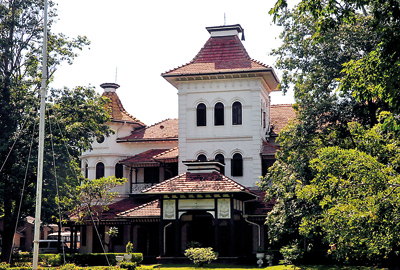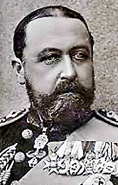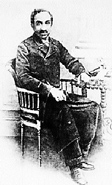The day the Queen came to Queen’s Road
Queens come and go. When Queen Elizabeth II came to open the new British Council Library in Colombo in 1981, she finally graced a prestigious Colombo 3 street that appeared to have been named after her, but was in fact named after someone else, a wealthy Ceylonese walauwe lady.

College House: Once Regina Walauwe, the property of T.H. A. de Soysa
The Queen may or may not have been aware that just 300 yards from where she stood, in the British Council garden, her great-grand-uncle Alfred, second son of Queen Victoria, had been entertained in extravagant style at the home of Charles Henry de Soysa, the country’s richest man in his time, 104 years earlier. The legendary dinner took place at Mr. de Soysa’s palatial residence, Bagatelle Walauwe, later named Alfred House, after the royal guest.
The Tale of the Prince who came to Dinner Next Door was a favourite story, whenever Mother would take us for a walk up Queen’s Road. As we turned into Alfred House Road, we would hear about the Prince and the Dinner, and the golden dishes and plates and forks and spoons made for the occasion, and how the royal guest was so taken with what he saw that his host presented him with the entire set of gold and silverware, studded with rubies and sapphires and emeralds. The story had all the glitter and aura of a fabulous fairytale. The difference was that this was a real story, with real gold.
(Mother, a violinist, may or may not have known, but would surely have liked, the bio detail that Prince Alfred of Saxe-Coburg and Gotha, later Duke of Edinburgh, had studied violin.)
As we walked past the gates of the surviving portion of the famous house, also called Alfred House, we imagined that historic Colombo dinner, possibly the grandest ever given in this country. These were pre-electricity times, so the dinner had to be candle-lit, with a thousand candles, in candlesticks and candelabras. The golden glow of the candles shone on the surfaces of the gold tableware and cutlery and precious stones. Shadows played on the walls as the liveried household staff served the guests. It was a fabulous, intimate scene of gold soaked in gold.

Prince Alfred
That 1870 visit put a royal seal on the neighbourhood we grew up in. The ghosts of that occasion haunted the length and breadth of the 120-acre de Soysa estate.
The parameters of the estate were the Galle Road and Thurstan Road on the west and the east, and School Lane and Bagatelle Road at the south and north ends. The land was covered with coconut trees and cinnamon and wild vegetation. Charles Henry de Soysa had seven sons and seven daughters, and they were all given a share of the estate. One of the first pieces of land to be sold to outsiders was the plot bought at the turn of the 20th century by Dr. Frederick George Spittel, our great-grandfather.
Dr. Spittel’s house Weimar stood behind Lakshmigiri, the grand house and garden built by Charles Henry de Soysa for his son Alfred Joseph Richard (A.R.J.).
The S of de Soysa is figured in the wrought iron gates facing Thurstan Road. Aligned with Lakshmigiri, on the other side of Queen’s Road, was Regina Walauwe, named after Regina Perera Abeyewardene, wife of Thomas Henry Arthur (T.H.A.) de Soysa, the fifth son of Charles Henry. This house was later sold to the University of Colombo and as College House served as a library and administrative centre for the campus across the road.
The gravel driveway that ran through the de Soysa estate, connecting Thurstan Road with Alfred House at the far end, was called Regina Paara (Road). In time, the Latin “queen” turned English and Queen’s Road was established. Those who lived in the neighbourhood could not help but feel the royal touch. The royal effect could be impressive, and sometimes comic.
Late one evening in the early Sixties, Older Brother was stopped by a Policeman for riding a bicycle without a headlamp. When asked for name, address and school, Older Brother said, “Prins, Queen’s Road, Royal College.” He was warned not to be “smart.” (In those days, the officers of the law spoke English, and some spoke the Queen’s English.)

Charles Henry de Soysa
The Queen of England, Elizabeth II, visited Ceylon in 1954, shortly after her Coronation. Our family joined the crowd on the Galle Road to see the royal progress. Being a baby, we were in someone’s arms, possibly Grandmother’s.
The Queen was here again, 28 years later, on a state visit. She came to Alfred House Gardens to open the British Council Library on the morning of October 21, 1981. She arrived at the front gates and made her exit through the rear gates, which opened on to 33rd Lane, an extension of Queen’s Avenue.
We had gathered once again to see the Queen. The procession of cars made their sedate way down 33rd Lane. The royal visitor was seated on the right side of her vehicle, the side facing the small crowd at the cross-road. As the car turned into Queen’s Road, the monarch smiled and waved, and long seconds later, the car slowed at the top of the road, turned left, and disappeared.
The Queen of England had come and gone.



